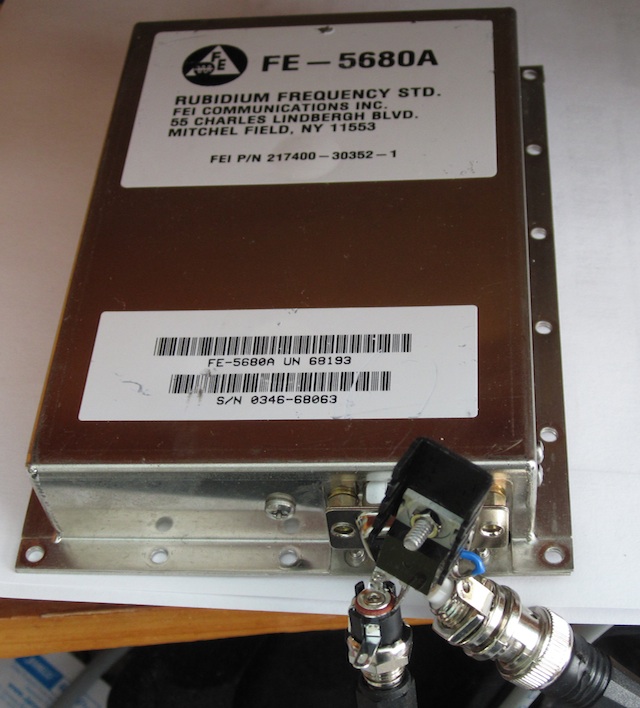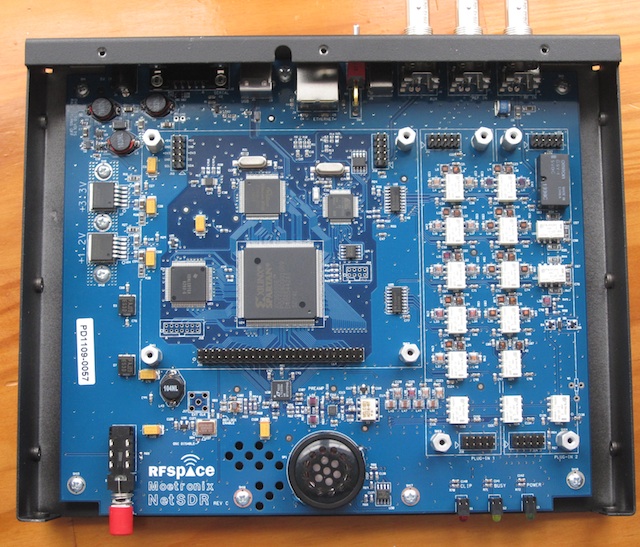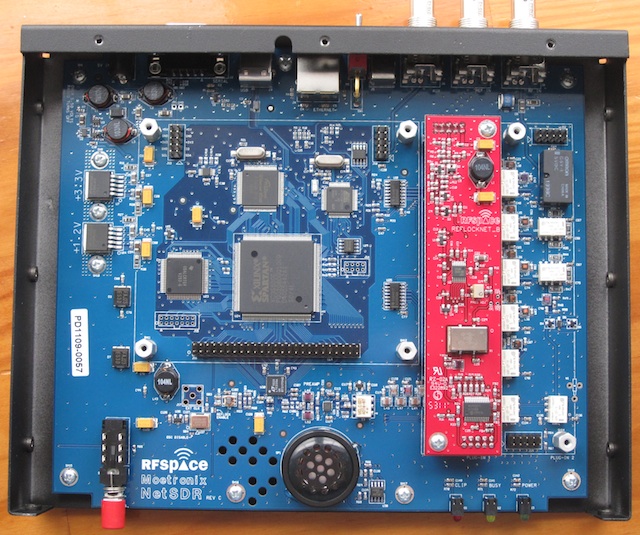I recently acquired a FE-5680 rubidium frequency reference off eBay. This is a high stability 10 MHz frequency reference. I also bought the REFCLOCK option for the netSDR directly from RF-Space, which takes the 10 MHz as a reference input, and produces an 80 MHz clock for the A/D, locked to the reference input. The result is less drift in the radio. The stock netSDR drift is already extremely low, but I want to do some observations of RF carriers over a long time period, so I wanted to reduce the drift even further.
Here’s a picture of the reference I bought, it was around $55 shipped, from China of course.

The reference requires 16V at just under 2A peak, as well as 5V at a lower current. I used an old laptop power supply, and rigged a 7805 to produce the 5V. Unfortunately all input and output is via a DB-9 connector. The 16V is applied via the barrel connector on the left, and the 10 MHz comes out the BNC on the right.
Here’s the inside of the netSDR receiver:

And after installing the REFCLOCK module:

I’ll post some followup articles with long term waterfalls, and we’ll see how the drift looks.
But how does the rubidium frequency reference work? From the FE-5680 technical manual:
The Rubidium Physics Package incorporates a rubidium cell, rubidium lamp, and servo electronics to utilize the ground-state hyperfine transition of the rubidium atom, at approximately 6.834x GHz.The VCXO is locked to the rubidium atomic resonance in the following manner. The VCXO frequency of 50.255x MHz is an exact sub-multiple (36) of the atomic resonance frequency at 6.834x GHz. A microwave signal, having a frequency in the vicinity of 6.834x GHz, is generated from the nominal 50.255x MHz VCXO input. This microwave signal is used to resonate vaporized rubidium atoms within a sealed glass Rb resonance cell that is placed in a low Q microwave cavity.
The microwave frequency generation method is designed so that the VCXO frequency is exactly 50.255x MHz when the microwave frequency is exactly equal to 6.834x GHz. The frequency of the signal applied to the microwave cavity can be maintained equal to 6.834x GHz by generating an error signal when the frequency varies, and using this error signal to servo the VCXO via its control voltage.
The error signal is generated in the physics package. Light from the rubidium lamp, produced by an excited plasma discharge, is filtered and passed through the rubidium resonance cell where it interacts with rubidium atoms in the vapor. After passing through the resonance cell, this light is incident upon a photocell. When the applied microwave frequency is equal to 6.834x GHz, the rubidium atoms are resonated by the microwave field in the cavity; this causes the light reaching the photocell to decrease. The decrease in light, when the microwave frequency is equal to the sharply defined Rubidium frequency, is then converted electronically to an error signal with phase and amplitude information that is used to steer the VCXO via its control voltage and keep it on frequency at 50.255x MHz.
The VCXO operates nominally at 50.255x MHz. The VCXO has two isolated outputs; one output is provided to the Rubidium Physics Package for comparison purposes, and the other output is used as the clock input for direct digital synthesis within the Synthesizer.

Pingback: An Afternoon in the 1230 kHz Graveyard | HFUnderpants.com
Pingback: GPS Disciplined 10 MHz Reference | HFUnderpants.com